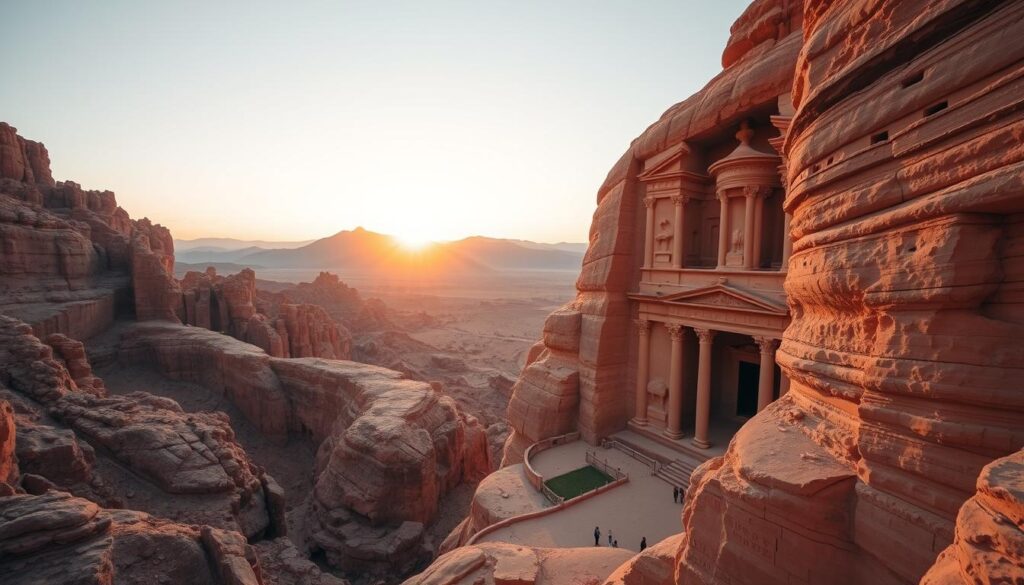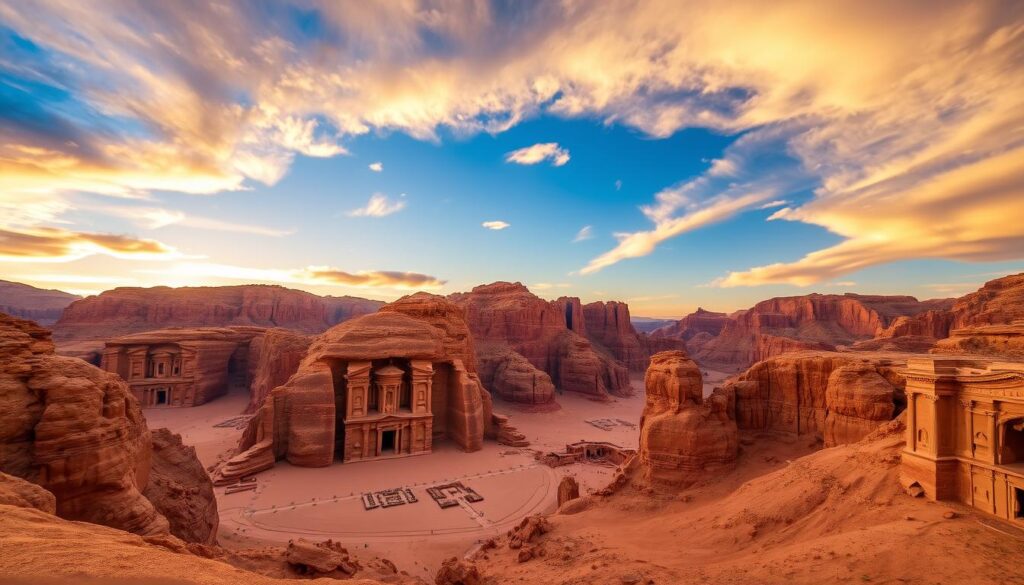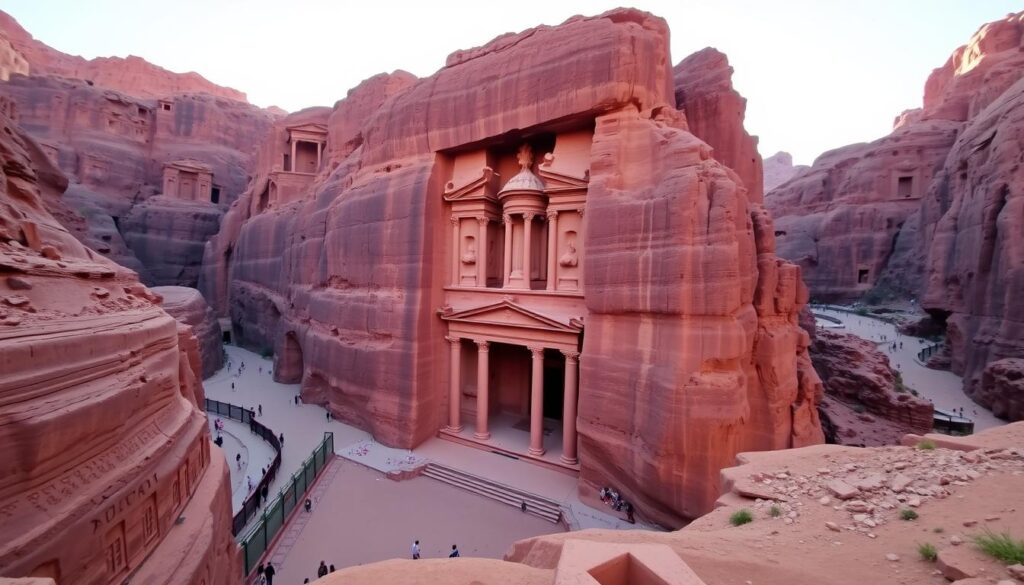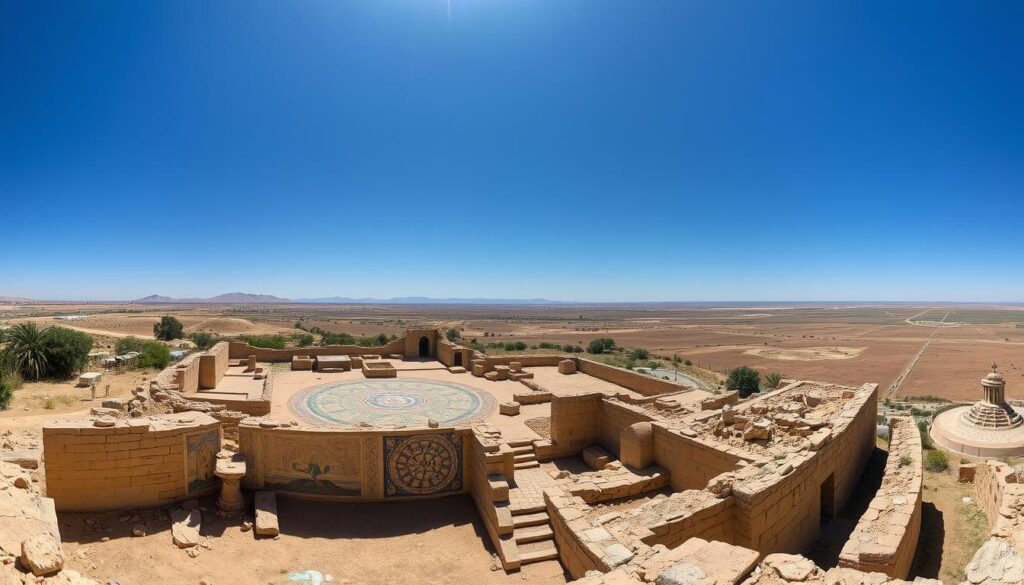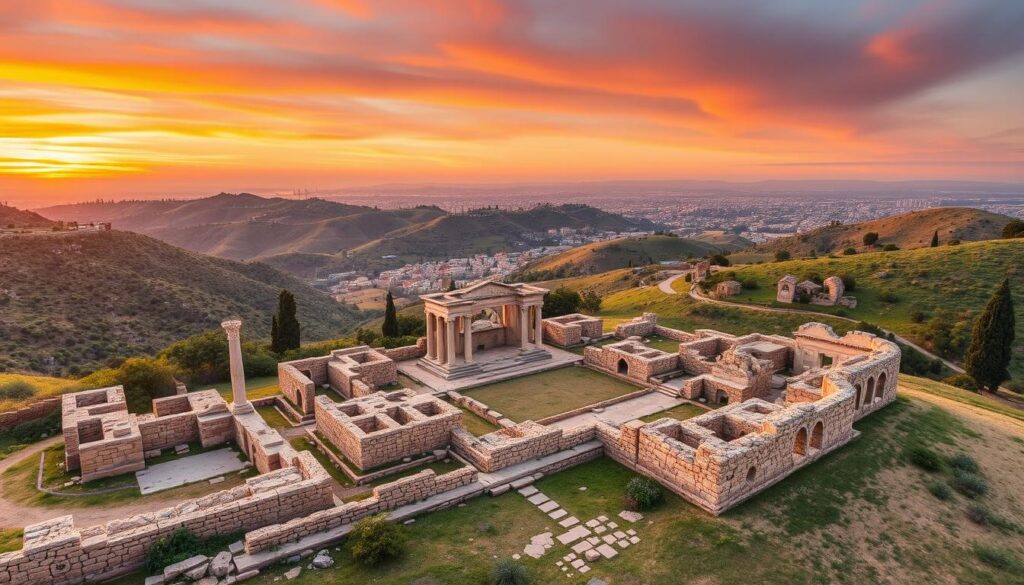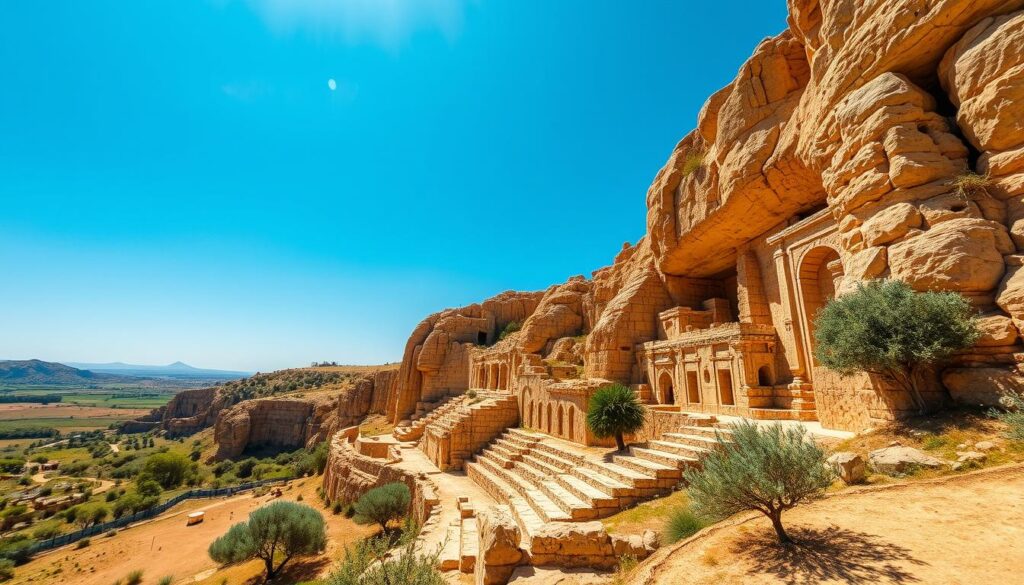Standing at the edge of towering sandstone cliffs, I saw the ancient city of Petra. It was a UNESCO World Heritage Site, known as the “Rose-Red City.” This was just the start of my journey through Jordan’s ancient wonders.
From the Roman ruins of Jerash to the Byzantine mosaics of Umm ar-Rasas, Jordan is full of history. This country has much more to offer than just Petra.
Key Takeaways
- Jordan’s ancient ruins include many sites, like Petra, Jerash, and Umm ar-Rasas, all UNESCO World Heritage sites.
- These places show the rich history of the region, with influences from many civilizations.
- Visitors can see ancient cities, desert castles, and sacred sites. Each one offers a glimpse into the past.
- There’s more to see in Jordan than just Petra. Many other archaeological wonders await discovery.
- Exploring Jordan’s ancient ruins lets you dive into the Middle East’s culture and history.
Discovering the Ancient Wonders of Jordan’s Archaeological Heritage
Jordan is home to ancient cities and UNESCO World Heritage Sites. These places offer a peek into the region’s rich history. From Petra to the Umayyad desert castles, these sites tell stories of past civilizations.
UNESCO World Heritage Sites in Jordan
Jordan boasts UNESCO World Heritage Sites like Petra and Umm ar-Rasas. These places show off the region’s architecture and cultural influences. They highlight Jordan’s ancient past.
Historical Significance of Jordanian Ruins
The ruins in Jordan tell a story of history. They span from the Hellenistic to the early Islamic eras. Each era left its mark, creating a mix of architectural styles and cultures.
Overview of Major Archaeological Periods
Jordan’s history stretches back millennia. The Nabataeans built Petra in the 4th century BC. The Romans left their mark in Jerash, while the Byzantines are seen in Umm ar-Rasas.
The Umayyads built desert castles. Each era adds to Jordan’s cultural tapestry, making it a hub for cultural tourism.
| Archaeological Period | Significant Sites in Jordan |
|---|---|
| Nabataean | Petra |
| Roman | Jerash |
| Byzantine | Umm ar-Rasas |
| Umayyad | Desert Castles |
“Petra, with its stunning rose-hued architecture and intricate rock-cut structures, is a true marvel of the ancient world and a testament to the ingenuity of the Nabataean people.”
The Magnificent City of Petra: A Wonder of the Ancient World
Carved into the desert sandstone, the ancient capital of the Nabataean civilization, Petra, stands as one of Jordan’s most iconic archaeological sites. This remarkable rock-cut architecture has earned the city recognition as a Wonder of the Ancient World. It captivates visitors with its impressive facades and natural setting.
The site’s most famous structure, the Al-Khazneh (or Treasury), towers an impressive 130 feet tall. It showcases the ingenuity and skill of the Nabataean builders over 2,000 years ago. Beyond the Treasury, Petra’s vast expanse offers a glimpse into the daily life and architectural wonders of this ancient civilization.
Visitors to Petra can explore the city’s narrow, winding roads. They can discover hidden gems and capture the essence of this archaeological site at their own pace. The ideal time to visit is during the cooler months, from October to April, when the weather is more temperate for extensive exploration.
To fully immerse oneself in the history and culture of Petra, hiring a local guide is highly recommended. These knowledgeable individuals can provide valuable insights into the site’s past. They can also highlight hidden gems and lesser-known stories that enrich the overall experience.
| Key Petra Facts | Details |
|---|---|
| Petra’s Status | One of the New 7 Wonders of the World |
| Excavation Progress | Only 15% of the city has been uncovered, with 85% remaining underground |
| Nabataean Presence | Petra was the capital of the Nabataean civilization, who developed over 2,000 sites in the region |
| Cinematic Legacy | The iconic Al-Khazneh has been featured in the Hollywood blockbuster “Indiana Jones and the Last Crusade” |
Petra’s enduring legacy as a Nabataean civilization and rock-cut architecture marvel continues to captivate travelers from around the world. It offers a unique window into the past and a sense of wonder that lingers long after the visit.
Jerash: The Pompeii of the East
Jerash is in Jordan’s north and is called the “Pompeii of the East” for its Roman ruins. These ruins are nearly 2,000 years old. They show how Greco-Roman and Levantine cultures mixed here.
The Roman Architecture of Jerash
Jerash has amazing Roman buildings. It has a huge hippodrome for 15,000 people, stalls, and temples for Zeus and Artemis. The city’s main roads, Cardo Maximus and Decumanus, meet at the center. This shows how ancient cities were planned.
The Nymphaeum and Religious Structures
The Nymphaeum is a standout in Jerash. It’s a big fountain from 190 AD for the Nymphs. Its carvings and a baptismal basin show the city’s importance. There are also early churches, like the Cathedral, which was a main temple.
Daily Life in Ancient Jerash
Archaeology in Jerash tells us about its people’s lives. There are Hebrew inscriptions and Umayyad houses and a mosque. This shows the city’s diverse culture over time.
Jerash is a key place for those into Roman ruins, ancient cities, and cultural tourism in Jordan.
“Jerash is described as one of the best-preserved Roman cities in the Middle East, dating back approximately 2,000 years.”
Umm ar-Rasas: A Testament to Byzantine Artistry
Umm ar-Rasas is near Madaba and shows the Byzantine era’s artistry. It’s a UNESCO World Heritage Site at 31°30′2.83″N 35°55′12.95″E. It has many Byzantine churches with beautiful mosaics and architecture.
The Church of Saint Stephen is a highlight. Its mosaic floor, from 785 CE, is Jordan’s largest. It was made by six master mosaicists, including Staurachios from Esbus, Euremios, Elias, Constantinus, Germanus, and Abdela. Their work shows the Byzantine era’s skill and artistry.
Umm ar-Rasas was 760 meters high and a key church center in the Byzantine time. It has many churches and Greek inscriptions. The salient stylite tower shows the spiritual devotion of its people.
Umm ar-Rasas was named a UNESCO World Heritage Site in 2004. It gives a look into Jordan’s Byzantine history and culture. The site has ruins like arches, wells, and a winery, showing life in a Byzantine outpost.
| Umm ar-Rasas Facts | Details |
|---|---|
| Location | 31°30′2.83″N 35°55′12.95″E, Amman Governorate, Jordan |
| Elevation | 760 meters |
| Construction Date | 5th century CE |
| UNESCO World Heritage Site | Designated in 2004 under criteria i, iv, vi |
| Church of St. Stephen Mosaic | Dated to 785 CE, largest in Jordan |
| Mosaic Masters | Staurachios, Euremios, Elias, Constantinus, Germanus, Abdela |
| Stylite Tower | Rare example, 14 meters tall |
| Distance from Madaba | 30 kilometers |
| Transportation Options | Bus (1-2 JD, 30-40 mins), Taxi (10-15 JD, 20-30 mins) |
Umm ar-Rasas is a Byzantine treasure. It invites visitors to explore its art and architecture. Whether you love history or Byzantine art, Umm ar-Rasas offers an unforgettable experience. It showcases the region’s cultural heritage in a remarkable way.
“Umm ar-Rasas is a remarkable testament to the artistic and architectural brilliance of the Byzantine era, offering visitors a glimpse into the rich cultural heritage of ancient Jordan.”
Umm Qais: Where History Meets Natural Beauty
In the north of Jordan, Umm Qais, once Gadara, mixes ancient ruins with stunning views. It was a key city in the Roman Empire’s eastern edge. This place shows the area’s deep cultural history.
The Decapolis Legacy
Umm Qais was a part of the Decapolis, ten Greco-Roman cities in the Levant. These cities were crucial in the ancient world’s culture and economy. Today, you can see the remains of this era, showing the Roman era’s grandeur.
Architectural Highlights and Black Basalt Structures
Umm Qais stands out for its unique black basalt buildings. This dark stone contrasts with the light surroundings, making it a sight to behold. It’s perfect for those who love exploring ancient sites.
Panoramic Views and Modern Amenities
Visiting Umm Qais, you get to see amazing views from a restaurant. You can see the Sea of Galilee, the Yarmouk River, and Mount Tabor. It’s a great place to enjoy local food and wine while taking in the views.
Umm Qais is a special mix of history, architecture, and nature. It’s a top spot for anyone interested in Jordan’s ancient sites and culture.
Iraq al-Amir: The Hidden Gem of Ancient Jordan
Near the lively city of Amman, Iraq al-Amir is a treasure trove of history. It shows the deep Middle Eastern history and cultural tourism of Jordan. With over 10 caves from the Copper Age, it tells the story of ancient people’s lives.
The Qasr Al-Abd castle stands out here. Built in the 2nd century BC, it has lion carvings that still amaze today. The castle is surrounded by green hills, making it a beautiful place to visit.
Some cave entrances have early Hebrew inscriptions. These give clues about the Ammonite Jewish Tobiad family’s rule. This mix of ancient buildings and artifacts makes Iraq al-Amir a fascinating spot for history lovers and tourists.
“Iraq al-Amir is a hidden jewel that transports visitors to the heart of Jordan’s rich archaeological heritage.”
For history enthusiasts, adventurous travelers, or anyone who loves ancient ruins, Iraq al-Amir is a must-see. It’s surrounded by breathtaking landscapes and is full of historical wonders. This archaeological site is a true treasure waiting to be discovered.
Mount Nebo: Where Moses Glimpsed the Promised Land
Mount Nebo sits high in Jordan, a place of deep religious and archaeological importance. It’s where Moses saw the Promised Land before he died. The Mount Nebo area attracts many for religious tourism. People come to see its cultural heritage and explore archaeological sites.
Religious Significance and Biblical Connection
Mount Nebo is dear to Christians and Jews. It’s where Moses saw the land of Canaan, promised by God. The Moses Memorial Church, built in the 6th century CE, stands here. It has ancient church remains and mosaic floors.
Visitors can see the detailed mosaics. They help understand the site’s religious importance.
Ancient Mosaics and Archaeological Discoveries
The Mount Nebo area is full of archaeological sites. It has many discoveries that show its rich history. The Baptistry has a mosaic floor with hunting and pastoral scenes.
These mosaics show the art and culture of the Byzantine era. They are truly mesmerizing.
Other archaeological discoveries include ancient artifacts and architectural remains. There’s also evidence of early Christian monastic communities. Visitors can see these finds and learn about Mount Nebo’s history.
On clear days, Mount Nebo offers stunning views. You can see the Jordan Valley, the Dead Sea, and even Jerusalem. This view, once seen by Moses, lets visitors connect with history and enjoy nature.
The Desert Castles: Architectural Marvels in the Sand
Outside Petra, Jordan’s desert is home to amazing architectural wonders called the Desert Castles. These structures date back to the 7th and 8th centuries AD. They show the rich Middle Eastern history and the cleverness of early Islamic leaders.
Qasr Amra, Qasr Kharana, and Qasr al-Azraq stand out. Each has its own special design and history. Qasr Amra, built by Walid I, has frescoes that tell stories of life, philosophy, and poetry.
Qasr Kharana was built in 711 AD. Qasr al-Azraq was Lawrence of Arabia’s base in World War I. These sites show Jordan’s past, with stories of power, art, and strength.
Visiting the Desert Castles is a chance to explore Jordan’s history. You’ll see ancient civilizations, beautiful desert landscapes, and amazing buildings. From Qasr Amra’s frescoes to Qasr al-Azraq’s design, these sites amaze and inspire people from everywhere.
Discover more about Jordan’s LuxuryTour – Petra and and uncover the hidden gems that lie beyond the iconic city of Petra.
“The Desert Castles of Jordan are a testament to the ingenuity and cultural richness of the region’s early Islamic rulers, offering a captivating glimpse into the past.”
Preservation Efforts and Modern Archaeological Work
Jordan’s ancient sites are a wonder to the world. Ongoing efforts to preserve them are crucial. Challenges like the desert climate, tourism, and funding are tackled with a mix of strategies.
Conservation Challenges
The desert climate and many visitors at places like Petra and Jerash are big hurdles. Jordan’s sites face threats from climate change, needing quick action to protect them. Finding enough money for these efforts is a constant battle.
Current Archaeological Projects
- The Cultural Resource Management Initiative at Petra’s Temple of the Winged Lions works on restoration and artifact documentation. It also promotes eco-friendly tourism.
- Teams of local, international, and academic groups work together to study and save Jordan’s ancient sites.
- Excavations and studies aim to reveal more about Jordan’s cultural heritage and archaeological sites.
Thanks to these efforts, Jordan’s cultural heritage and archaeological sites will keep inspiring people. They will be preserved for future generations to enjoy.
Travel Tips for Exploring Jordan’s Ancient Sites
Discover Jordan’s deep cultural heritage with these expert tips. When visiting ancient sites, consider a local guide for a deeper dive. Visit in spring or fall for better weather and fewer people than summer.
Don’t forget comfortable shoes, sun protection, and respect for local customs. The Jordan Pass offers access to many sites and museums. Spend enough time at each site and see them at different times for unique experiences.
Jordan is a treasure trove of history and culture. Follow these tips to fully enjoy its ancient wonders. You’ll make memories that last a lifetime in this incredible country.
